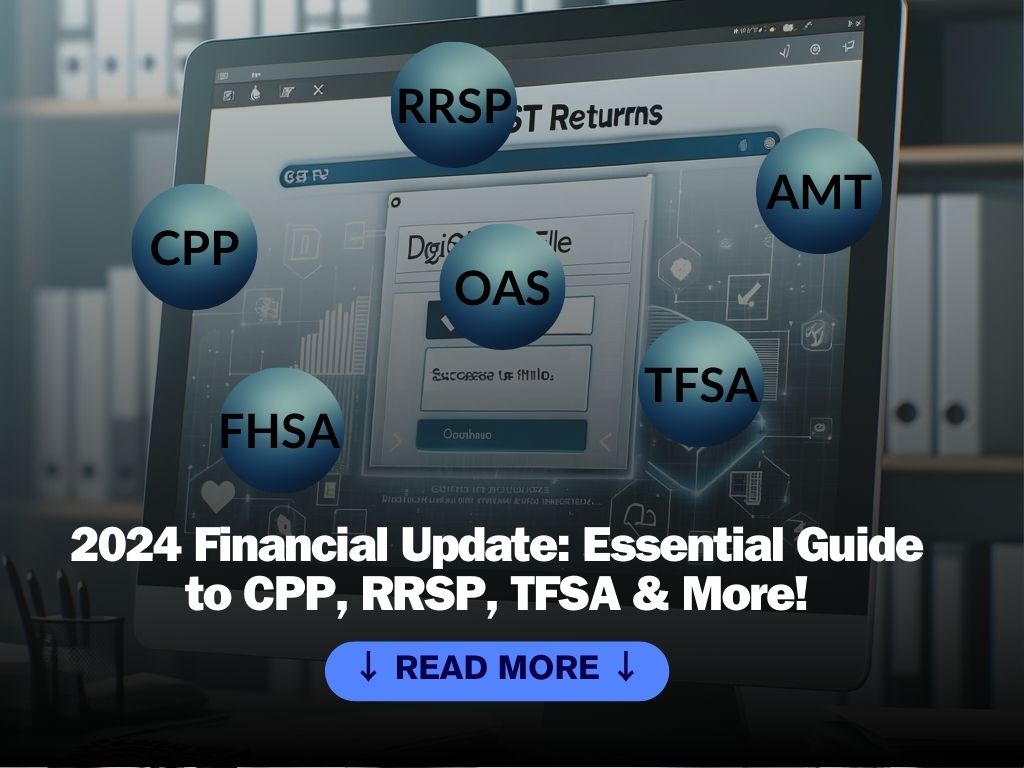Key Takeaways
- The Canadian government has announced several changes to the tax and benefit programs for 2024, affecting millions of Canadians.
- Some of the changes include increased contribution limits for RRSP and TFSA, enhanced CPP benefits, new FHSA program, revised AMT rules, and a reduced OAS clawback threshold.
- These changes may have significant implications for your financial planning and retirement goals. You should consult a professional advisor or use a reliable online tool like HustleHub to optimize your tax and savings strategies.
Hello, Hustlers! Are you ready for the new year? 🎉
As you may know, the Canadian government has announced several changes to the tax and benefit programs for 2024, affecting millions of Canadians. These changes may have significant implications for your financial planning and retirement goals. You should be aware of them and adjust your tax and savings strategies accordingly.
In this article, we will explain the main changes to the CPP, RRSP, TFSA, FHSA, AMT and OAS programs, and how they may affect you. We will also provide some tips and resources to help you make the most of these changes and achieve your financial dreams. 💰
Let’s get started!
Important Links:
CPP Changes
The Canada Pension Plan (CPP) is a mandatory social insurance program that provides retirement, disability, and survivor benefits to eligible Canadians. The CPP is funded by contributions from workers and employers, as well as investment income from the CPP Investment Board.
Also Read: How to Boost Your CPP Payment in 2023
The CPP is undergoing a gradual enhancement since 2019, which will increase the benefits and contributions over seven years. The enhancement aims to provide more income security for Canadians in retirement, especially for those who do not have access to a workplace pension plan.
The CPP enhancement will affect both workers and employers in the following ways:
- The CPP contribution rate will increase from 5.45% in 2023 to 5.7% in 2024 for both employees and employers. This means that you and your employer will each pay an additional 0.25% of your pensionable earnings (up to the yearly maximum pensionable earnings) to the CPP.
- The yearly maximum pensionable earnings (YMPE) will increase from $61,600 in 2023 to $63,700 in 2024. This is the maximum amount of earnings that are subject to CPP contributions and benefits. If you earn more than the YMPE, you will not pay or receive any additional CPP contributions or benefits on the excess amount.
- The CPP post-retirement benefit (PRB) will increase from 0.5% to 0.625% of your average monthly earnings for each year that you contribute to the CPP after age 65 (or after you start receiving CPP retirement benefits, whichever is earlier). The PRB is a monthly benefit that is added to your CPP retirement benefit if you continue to work and contribute to the CPP after retirement.
- The CPP retirement benefit will increase by about 50% for those who contribute to the enhanced CPP for 40 years. The CPP retirement benefit is a monthly payment that replaces part of your income when you retire. The amount of your benefit depends on how much and how long you contributed to the CPP, as well as the age when you start receiving it. You can start receiving the CPP retirement benefit as early as age 60 or as late as age 70. The earlier you start, the lower your benefit will be. The later you start, the higher your benefit will be.
These changes will result in higher CPP contributions and benefits for most Canadians. However, the impact will vary depending on your income level, contribution history, and retirement age. To estimate your CPP contributions and benefits, you can use the CPP Calculator on the Government of Canada website. You can also use HustleHub, a comprehensive online tool that helps you plan and optimize your retirement income, including CPP, OAS, RRSP, TFSA, and more. 💯
Also Read: How to Avoid Delays and Confusion with Your Canada Benefits Payment for January 2024
RRSP Changes
The Registered Retirement Savings Plan (RRSP) is a tax-advantaged savings account that helps you save for retirement. You can contribute up to 18% of your earned income (or a maximum amount) to your RRSP each year, and deduct your contributions from your taxable income. The money in your RRSP grows tax-free until you withdraw it, usually in retirement. You can also use your RRSP to buy a home or pay for education under certain conditions.
The RRSP contribution limit for 2024 is $29,210, up from $28,830 in 2023. This is the maximum amount that you can contribute to your RRSP for the 2024 tax year, based on your earned income in 2023. If you have unused RRSP contribution room from previous years, you can carry it forward and use it in 2024 or later years.
The RRSP deadline for 2024 is March 1, 2025. This is the last day that you can make RRSP contributions for the 2024 tax year and claim them on your 2024 tax return. You can make RRSP contributions at any time during the year, but you should make them as early as possible to maximize the tax-deferred growth of your savings.
The RRSP is a powerful tool to save for retirement and reduce your taxes. However, it is not the only option. You should also consider other tax-efficient savings vehicles, such as the TFSA, the FHSA, and the AMT. You should also be aware of the RRSP withdrawal rules and the tax implications of your withdrawals. To find out the best way to use your RRSP and other savings accounts, you can consult a professional advisor or use HustleHub, a smart online tool that helps you create and execute your personalized financial plan. 🚀
TFSA Changes
The Tax-Free Savings Account (TFSA) is a tax-free savings account that lets you save and invest for any purpose. You can contribute up to a certain amount to your TFSA each year, and withdraw your money at any time, tax-free. The money in your TFSA grows tax-free, and does not affect your eligibility for government benefits and credits.
The TFSA contribution limit for 2024 is $6,500, up from $6,000 in 2023. This is the maximum amount that you can contribute to your TFSA for the 2024 calendar year, regardless of your income. If you have unused TFSA contribution room from previous years, you can carry it forward and use it in 2024 or later years.
The TFSA is a flexible and versatile savings account that can help you achieve your short-term and long-term goals. You can use your TFSA to save for a vacation, a car, a home, an emergency fund, retirement, or anything else. You can also invest your TFSA in various types of assets, such as stocks, bonds, mutual funds, ETFs, GICs, and more. You can choose the level of risk and return that suits your needs and preferences.
The TFSA is a great way to save and grow your money tax-free. However, it is not the only way. You should also consider other tax-advantaged savings accounts, such as the RRSP, the FHSA, and the AMT. You should also be aware of the TFSA rules and the penalties for overcontributing or holding prohibited investments. To find out the best way to use your TFSA and other savings accounts, you can consult a professional advisor or use HustleHub, a simple online tool that helps you manage and optimize your finances. 🙌
FHSA Changes
The First-Time Home Buyers Savings Account (FHSA) is a new tax-advantaged savings account that will be available in 2024. The FHSA is designed to help first-time home buyers save for a down payment and other costs of buying a home. The FHSA will offer the following benefits:
- You can contribute up to $10,000 per year to your FHSA, and deduct your contributions from your taxable income. The maximum lifetime contribution limit is $40,000 per person or $80,000 per couple.
- The money in your FHSA grows tax-free until you withdraw it to buy your first home. You can withdraw your money at any time, tax-free, as long as you meet the eligibility criteria for the first-time home buyers program.
- You can invest your FHSA in various types of assets, such as stocks, bonds, mutual funds, ETFs, GICs, and more. You can choose the level of risk and return that suits your needs and preferences.
The FHSA is a new and exciting way to save for your first home. However, it is not the only way. You should also consider other options, such as the RRSP Home Buyers’ Plan, the TFSA, and the AMT. You should also be aware of the FHSA rules and the consequences of withdrawing your money for other purposes. To find out the best way to save for your first home and other goals, you can consult a professional advisor or use HustleHub, a user-friendly online tool that helps you plan and achieve your financial dreams. 🏠
AMT Changes
The Advanced Matching Tax Credit (AMT) is a new tax credit that will be available in 2024.
The Advanced Matching Tax Credit (AMT) is a new tax credit that will be available in 2024. The AMT is designed to encourage Canadians to save and invest for their future, by matching a portion of their contributions to eligible savings accounts, such as the RRSP, the TFSA, and the FHSA.
The AMT will offer the following benefits:
- You can claim a tax credit of 15% on up to $5,000 of your contributions to eligible savings accounts each year. The maximum annual tax credit is $750 per person or $1,500 per couple.
- The AMT is refundable, which means that you can receive it even if you do not owe any income tax. The AMT will be paid to you as a direct deposit or a cheque, after you file your tax return.
- The AMT is available to all Canadians, regardless of their income level. However, the AMT will be reduced by 5% for every dollar of income above $75,000 for individuals or $150,000 for couples. The AMT will be eliminated for incomes above $100,000 for individuals or $200,000 for couples.
The AMT is a new and generous way to save and invest for your future. However, it is not the only way. You should also consider other tax incentives and benefits, such as the RRSP deduction, the TFSA exemption, the FHSA deduction, and the OAS clawback reduction. You should also be aware of the AMT rules and the eligibility criteria for the eligible savings accounts. To find out the best way to save and invest for your future and other goals, you can consult a professional advisor or use HustleHub, a handy online tool that helps you optimize your tax and savings strategies. 📈
OAS Changes
The Old Age Security (OAS) is a monthly payment that provides income support to seniors aged 65 and over. The OAS is funded by general tax revenues and does not require contributions from workers or employers. The OAS is based on your residency and legal status in Canada, and is adjusted quarterly for inflation.
Also Read: How the CRA is Increasing Your OAS Pension in 2024
The OAS benefit amount for 2024 is $626.49 per month, up from $614.14 in 2023. This is the maximum amount that you can receive from the OAS program, based on your income and marital status. If you have a spouse or common-law partner who also receives the OAS, you will each receive the full amount. If you have a spouse or common-law partner who does not receive the OAS, you may be eligible for the Allowance or the Allowance for the Survivor, which are additional monthly payments for low-income seniors.
The OAS clawback threshold for 2024 is $79,845, down from $79,954 in 2023. This is the income level at which you have to repay part or all of your OAS benefits. If your income is above the threshold, you will have to repay 15% of the excess amount, up to the maximum OAS benefit amount. The OAS clawback is also known as the OAS recovery tax, and is deducted from your income tax.
Also Read: What Happens to Your CPP and OAS Benefits When Your Spouse Dies?
The OAS is a valuable source of income for seniors. However, it is not the only source. You should also consider other income sources, such as the CPP, the RRSP, the TFSA, the FHSA, and the AMT. You should also be aware of the OAS eligibility rules and the impact of your income on your OAS benefits. To find out the best way to maximize your income in retirement and other goals, you can consult a professional advisor or use HustleHub, a reliable online tool that helps you plan and manage your retirement income. 🎁
Conclusion
As you can see, there are many changes to the tax and benefit programs for 2024, affecting millions of Canadians. These changes may have significant implications for your financial planning and retirement goals. You should be aware of them and adjust your tax and savings strategies accordingly.
To help you navigate these changes and achieve your financial dreams, you can use HustleHub, a comprehensive online tool that helps you create and execute your personalized financial plan. HustleHub helps you optimize your tax and savings strategies, plan and manage your retirement income, and track and improve your financial health. HustleHub is easy to use, secure, and affordable. You can sign up for a free trial today and see for yourself how HustleHub can help you. 😊
We hope you found this article helpful and informative. If you have any questions or feedback, please feel free to contact us. We would love to hear from you. Thank you for reading and happy new year, Hustlers! 🥂









